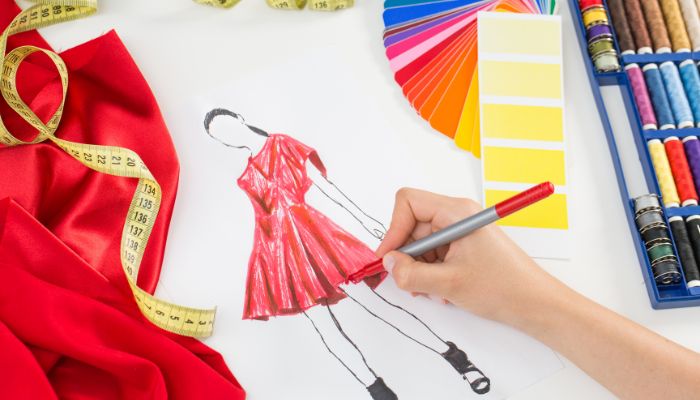Fashion isn’t just the beautiful clothes you wear; fashion is who you are, the stories you tell without saying a word, the trends you create and the beauty you inspire in the world around you for millions. Aspiring designers, this is the path for you if sketching out your big ideas on paper, mastering luxurious fabric in edgy styles that deliver your vision to the public is your dream life.
This guide will show you how to become a fashion designer, with examples of developing your skills and leaving your mark in this exciting space.
Why Choose a Career in Fashion Design?
Selecting a career in fashion design means entering a universe of creativity, passion, and new and endless possibilities. As a designer, you can get so deep into how you want people to express themselves, and you can create these fantastic pieces of art that they wear. A career where innovation is celebrated and each day brings an opportunity to bring new ideas to life in an international, dynamic arena.
Fashion design is more than clothes — a lifestyle where imagination is limitless. If your ambition is to create your brand or a legacy, this career allows you the latitude of doing so. When thinking about how to become a fashion designer, just remember: this is a journey created by inspiration, persistence and the ability to actually make dreams come true.
Also Read: Top 10 Fashion Designers in India You Should Follow
Essential Skills You Need to Become a Fashion Designer

From personal styling to merchandising, you need to know these skills before you step into the fashion arena:
- Creative Vision: Go beyond the limits of the routine, defy commonality, and create motivating trends.
- Technical Skills: Learn sewing, draping, pattern making and garment construction so you can do just that.
- Fabric Knowledge: Learn how materials move and feel and how to work with them for great designs.
- Attention to Detail: Precision distinguishes true designers from perfect stitches to immaculate finishes.
- Strong Communication: Making your vision known to clients, teams, and manufacturers for it to come to life.
- Business Acumen: Master the business of fashion, learning to market, brand, and grow your fashion business for sustainability.
These skill sets shouldn’t just be necessary but rather be prepared as a foundation to become a successful fashion designer in today’s fast-paced yet competitive industry.
How to Become a Fashion Designer
1. Develop Your Fashion Skills
Developing the basic skills you need to succeed in the fashion world. Spend time making sketches of different types of clothing, from everyday casual wear to high-class couture garments. This will teach you to train your eye for style, proportion and creativity.
In addition to sketching, you can practice sewing techniques, play around with various fabrics, and explore the rich history of fashion. Practice, practice, experiment, the more you practice, the more of a sharp designer you become.
2. Get a Formal Education (Optional but Highly Valuable)
Natural skill can only get you so far for the most part; formal training sharpens your skills and broadens your knowledge. If possible, study styling or fashion design (you can enrol in online courses too to supplement or replace) − it will help you learn better art, get exposure to advanced techniques, more mentorship opportunities, and collaboration with the industry.
World-class programs such as Parsons School of Design, Central Saint Martins or, ideally, the Fashion Institute of Technology (FIT) provide you with the perfect investment environment to grow your talent in knitting doors to exciting opportunities in the fashion world.
3. Build an Impressive Portfolio
Your portfolio is the one singular fashion tool that can make or break you. Create a portfolio/book of your garments, sketches, fabric swatches, technical sketches, and well-shot photos of your pieces.
Ensure your portfolio illustrates your distinctive style, versatility, and attention to detail. It should showcase your development and abilities and positively impact potential clients or employers.
4. Gain Hands-On Experience
Fashion internships and apprenticeships provide essential practical experience. Gain exposure to the industry by collaborating with established designers, well-known fashion houses, or even up-and-coming boutique brands.
This experience in the real world gives you the hands-on knowledge and the insider knowledge that no textbook can teach you, so you learn how the fast-paced fashion industry works and how to prepare yourself to succeed in your career.
5. Design Your Brand and Launch Your Collection
Create your designs and release small capsule collections to introduce your skills. Work with influencers or showcase your work on places like Instagram, Etsy or your website for visibility.
By establishing a strong brand identity and online presence from the get-go, you can create momentum by accessing more significant opportunities and engaging with larger audiences that may pave the way for tremendous success throughout your fashion journey.
6. Network and Stay Updated
Get inspired by attending fashion weeks, exhibitions, and trade shows to meet other industry professionals. Networking online allows you to join Fashion Communities, collaborate with other creatives, and even spark a meaningful conversation.
Staying ahead of upcoming trends, new technologies such as 3D design, and the demand for sustainable fashion. In an increasingly competitive fashion industry, networking is the key to consistency and staying ahead.
Also Read: Starting a Hijab Business: Essential Steps for New Entrepreneurs
Additional Tips for Aspiring Fashion Designers
- Keep Curious: Look for inspiration from different cultures, art forms, and historical trends. The world in which you live is rich with creative influence.
- Keep Educating Yourself: Enroll in short business, marketing or new fashion technologies courses. Studying outside of design will help you stand out in the industry.
- Be Prepared for Rejection: Every well-known designer has gone through it. Reframe failures as growth opportunities and sources of fuel for your next big breakthrough.
- Encourage Critique: Criticism is a great resource! Pay attention, hone your craft, learn what you can, and expand your creative vision with each nugget of feedback that falls into your hands.
- Keep Being You: Your uniqueness is your only greatest asset (there’s no second!). Embrace evolution, but stay true to your specific style throughout the process. Continue to defy the odds, and allow your imagination to soar.
Your most significant strength is your uniqueness. Be even more yourself, and become relevant with the time.
Conclusion
Now that you have a new perspective on how to become a fashion designer, it’s your time to step into the world of creativity, resilience, and innovation. But start in small batches, and continue to grow and challenge yourself.
It’s waiting for the new voices, ideas, and ardent designers — like you.
Your journey begins today. Sketch that first design, sew that first stitch, and have the audacity to create something memorable.
FAQs:
1. What education do I need to be a fashion designer?
Ans: Not directly, but a degree can refine your skillset, expand social capital and enhance career prospects.
2. Which degree is best for fashion designing after 12th?
Ans: Bachelor of Design (B.Des) in Fashion Design or Bachelor of Fashion Technology (B.FTech) are the best degrees after 12th.
3. Can I become a fashion designer without knowing how to sew?
Ans: Yes, although some sewing ability is useful you can concentrate on the design and work with professionals.
4. How long do you study to become a fashion designer?
Ans: It usually takes 3-4 years with formal education and additional time to get hands-on experience.
5. How much does a fashion designer make in the beginning?
Ans: Fashion designers at the entry level average between $35,000 and $50,000 annually.
6. How do I start my fashion brand??
Ans: Develop a distinct style, build an online presence, and expand via networking and collaborations.



